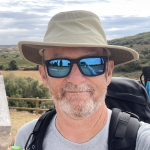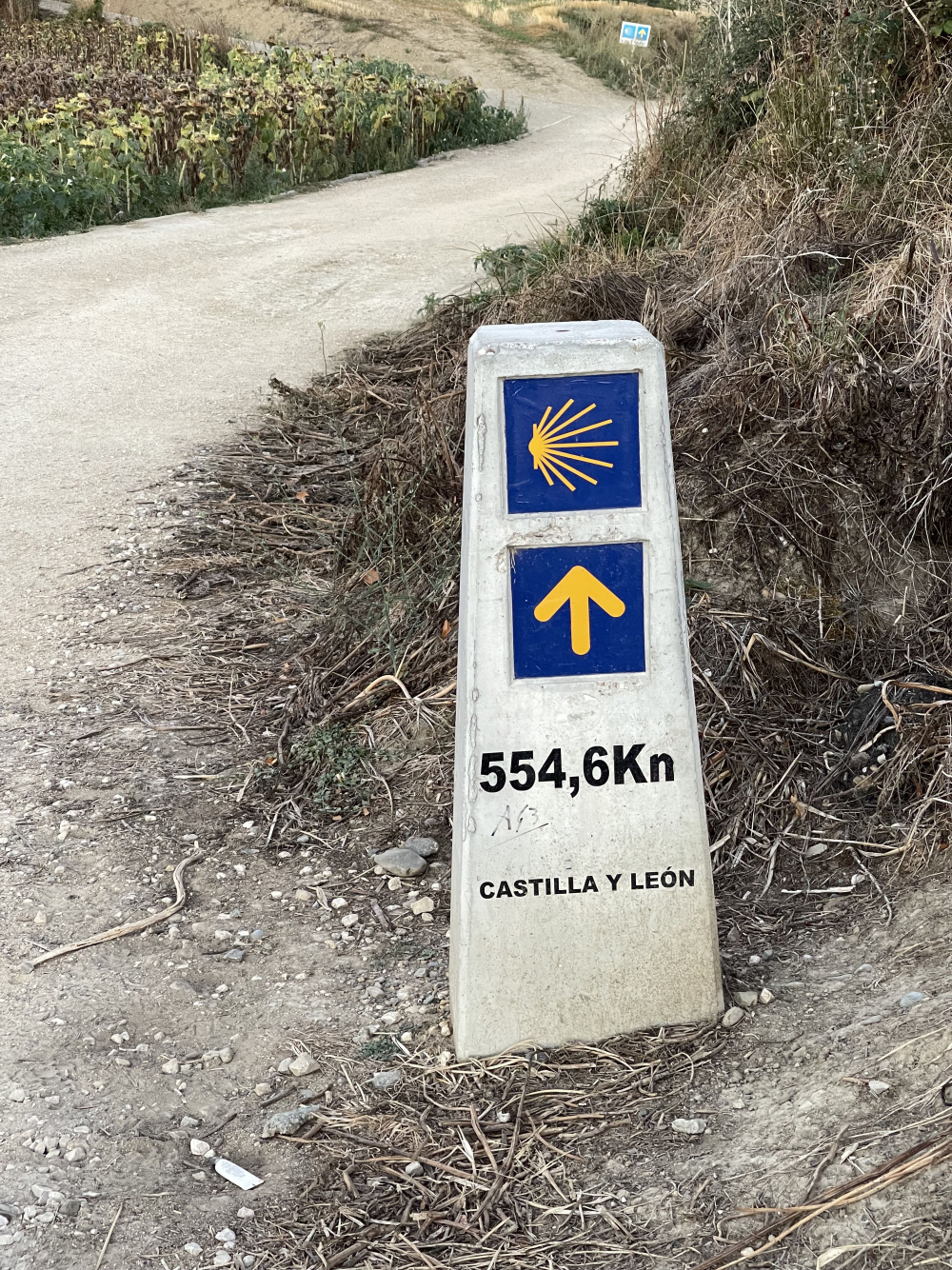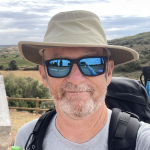A guy who I will call "Overthinker" posted several weeks ago in a popular online forum a list of the 21 fears he had about walking the Camino de Santiago.
I used his post as a writing prompt.
If you are not familiar with the Camino de Santiago, Dan Mullins' "My Camino - the podcast" is a heart-felt introduction.
Dear Overthinker,
We are kindred souls. Thank you for helping me write about my recent experiences on the Camino Frances. You could not have given me anything better to write about today, as I am still processing that amazing journey.
I must not fear. Fear is the mind-killer. Fear is the little-death that brings total obliteration. I will face my fear. I will permit it to pass over me and through me. And when it has gone past I will turn the inner eye to see its path. Where the fear has gone there will be nothing. Only I will remain.
Frank Herbert, Dune
On 10 Sep 2022, Cristina and I walked up to a mile marker just outside of Belorado in the autonomous community of Castilla y Leon in Northern Spain. The sign struck fear in my heart, real FEAR. I know. I know. Fear is nothing but False Evidence Appearing Real.
So, there we were, staring at this three-foot-tall, cement column, and I was feeling fear. I am a 59-year-old male, carrying a 20-pound backpack, committed to making the journey all the way to Santiago de Compostela from Saint Jean Pied de Port, known as the Camino Frances, on foot, over 500 miles, never shipping my backpack forward, never taking a taxi or bus.
In my head, I knew that my personal commitment and expectations had set up this doubt I was feeling. This is likely why so many veteran pilgrims say to leave your expectations at home--just go!
But, I think it is impossible to not have expectations. Reality bites or kisses us depending on how we deal with our met and unmet expectations.
We had invested a lot of time and money preparing. Two long years of training. Cristina is stronger than I and had an easier go of both the training and the actual Camino. I started out training in 2020 by walking 1-2 kilometers, which would swell my ankle up like a softball. Our last training hike before catching a plane to Spain was a quick 7 kilometers with full packs. The week before we had hiked two times reaching 12 kilometers in full packs.
One day after my 59th birthday, we set foot out of Saint Jean Pied de Port and crossed the Pyrenees. 13 days later I was standing in front of this debilitating piece of cement calling it, "excrement."
In preparation for our adventure, I leveraged all of my 59 years of boy-scout, missionary, military, hunter-gatherer, and two boy-rasing fatherhood experiences.
Let me go back to that time when COVID ground all of the World to a standstill and knocked the wind out of so many of its citizens that it didn't kill. Sorry, that sounded a bit unempathetic, but I was witnessing many friends and acquaintances who might as well have died given how they were not living in any meaningful way, anymore. I vowed after three months of depressing lockdowns to go outside and walk.
When we felt the "call of the Camino" I said to Cristina that I wanted to challenge myself to walk the entire Camino Frances as one of those big hairy audacious goals (BHAG) I often use to motivate myself. I wanted to get myself back into "shape." I use BHAGs to help me exceed my expectations of myself. My lack of mobility was becoming a life drag and I didn't like my mobility prospects for the next 20-30 years if I did not change something. I did not want to end up sitting in an armchair like my father or Cristina's father had chosen to do for the last 10 or so years of their lives.
We looked at each other and said, "If not now, when?" That's a contrarian life-prompt to embrace while a pandemic has the world spinning upside down and sideways.
We discussed our preparation strategy, often. In fact, we laid out a plan to for physical, mental and spiritual preparation. We'd been listening to Camino veterans on podcasts and YouTube videos talking about how the first stage would be a physical challenge and then comes the Meseta, the mind-bending challenge, followed by the demanding spiritual, but most rewarding final stage through Galicia into Santiago de Compostela.
I know that spiritual is a loaded word for many. Physical and mental challenges are not so hard to define and talk about, right? Isn't the opposite of fear to hope? Hope is a spiritual concept, right? I think fear and doubt are spiritual concepts too. Well, on the Camino it was for me.
It takes real commitment to embark on a pilgrimage like the Camino de Santiago. I was committed. Cristina was committed. I had come on this pilgrimage to walk it, all of it. If physical, mental, and spiritual challenge was to be my lot, then challenges I would endure. I came on this pilgrimage to have a transformational experience. I had no illusions that it could be hard at times. Because of our discussions, I think Cristina felt the same.
I read as many books about the Camino and Camino memoirs as our budget would allow.
I read Shannon Wallis’s wonderful book titled, “WE The Change.” I highlighted the following passage where Shannon describes recovering, somewhere midway in a hotel room, where her husband visits her, pours her a bath, and listens to all her complaints about the aches, pains, and travails of the Camino. Here is what he said to her.
What were you thinking? It wouldn’t be a pilgrimage if it weren’t challenging.
Shannon Wallis, WE the Change
Despite all of our preparations, there we were, at the beginning of day 13 of our 37-day march to Santiago, just a few steps outside of Belorado. I had 4 open blisters, arthritis kicking up in my hips and lower back, and my ankle all swelled up. We had not yet reached the Meseta and the physicality of our planned and prepared for Camino was beating me down. I was doubting if I could make it all the way to Santiago as planned.
"The Way" was playing with my mind junk as a cat plays with a mouse.
This mile marker stopped me in my tracks. I don't know how I had the presence to snap a photo, but I got the picture and when I ponder it, it transports me back to that day with all of its personal significance.
Everyone asks you why are you walking the Camino. As you have read, I had given in to "great expectations" for our Camino. Cristina had her motivations, while I came on this long walk expecting to figure a few things out about myself and to think about what I would like to do with the rest of my life.
Instead of answering in simple terms the most often asked Camino question EVER. I enjoyed playing up my answer by saying...
"I'm taking my mid-life bones on a long contemplative walk to test my philosophy on how to live the good life. What better place on earth to put to test a life philosophy than on one of the most famous pilgrimages in the world. I was raised in a Christian tradition, so it's not a significant leap, right?
It doesn't matter to me that the Camino was created by a conniving Catholic Bishop to aggrandize his diocese and supported by Medieval Kings and Queens who wanted to push the Moors off of the Iberian Peninsula. And they were successful in convincing the Pope to bless the venture because it would bring attention from all over Europe to Christianity and the crusades, thereby establishing what has evolved over more than a thousand years into one of the three principle Christian pilgrimages. And what about the Masons and Knights Templars? The Camino is stuffed full of interesting and significant stuff.
Yes, for over a thousand years now, schmucks like us have walked to honor the supposed bones of the Apostle Santiago enshrined in a majestic Cathedral. And for as many and varied reasons as there are stars in "La Via Lactea", The Milky Way, or Compostela as it is known, they have suffered the travails of said journey. Compostela means a field of stars. Santiago de Compostela is Santiago under a field of stars.
With a little research, I had come to the conclusion that the Camino de Santiago represents the best example of an archetypical, mythological, hero's journey. And it's still available to modern, mortal, pilgrim-adventurers like us. After a thousand years, the Camino still attracts hundreds of thousands of people from all over the world."
I love how people look at me when I say all of that.
"No, I've developed over the years, a personal philosophy for how I can live the good life. The Camino is considered a metaphor for life. So it seems like a great proving ground to test and elaborate my philosophy and grand strategy for living well. Heady shit, right?"
Just like the Camino, life is not all roses and cafes-con-leche. Therefore if suffering was to be my lot, then suffering I was ready to endure. I came on this pilgrimage to have a transformational experience. I like to say, I made a "Pilgrim's Wager."
I remember how the day I bought the non-refundable airline tickets to Spain, it got real. I thought to myself that day, ok, I'm feeling it, but I will go on this journey, as prepared as possible, and with no illusions.
I come from a philosophical approach to life that says you can never over-prepare. I was a Boy Scout. What can I say?
But, I've also learned over the years that it is not so much the preparation, rather how you deal with the setbacks that get you through the crucible moments.
At some point it's, "Ready or not, here we go!" Often the decision to go is the easiest part of the journey. It's the making or keeping that decision right, where the hard work piles up.
And from sad experiences, I know there is a cold place waiting for timid souls.
It is not the critic who counts, not the one who points out how the strong man stumbled or how the doer of deeds might have done them better. The credit belongs to the man who is actually in the arena, whose face is marred with sweat and dust and blood; who strives valiantly; who errs and comes short again and again; who knows the great enthusiasms, the great devotions, and spends himself in a worthy cause; who, if he wins, knows the triumph of high achievement; and who, if he fails, at least fails while daring greatly, so that his place shall never be with those cold and timid souls who know neither victory nor defeat.
Teddy Roosevelt
So there I was, beginning another beautiful Camino morning, just a few steps out of Belorado, paralyzed by fear and doubt.
The blasted mile markers or as they should be called, kilometer-markers are called "mojones" in Spanish.
The evil Spanish Language Lords must have loved giving multiple meanings to their favorite words. "Mojon" always meant something different to me, a former Air Force Spanish Linguist. "Mojon" brings up images of large floaties in outhouses, but not in Spain. The Spanish love these signposts. They must, right? They are everywhere and can be seen in every stage of repair from crumbling to brand new.
So how can a mojon have knocked the wind out of me, so to speak, so you might ask? At that moment the simple fact dawned on me that 554.6 Kilometers was not how far we had walked, but rather how far we had left to go.
None of these bloody kilometer markers tell you how far you have come. They don't mark the distance traveled. How could they when there are thousands of different places to begin the journey? They tell you how far you have left to go to Santiago. You can begin almost anywhere on the Camino Frances and know down to to the kilometer how far away lays the blessed apostle's bones. That can be motivating or super debilitating, depending on your physical and emotional condition at the time.
It was true, these mojones had become a serious drag on my motivation to continue.
So, I said to myself, "Lance, from here to forward you had better find a better way to think about these wicked signposts." I determined to do a little quick mental math exercise at each new mojon, flipping their significance. 800-554 = 246.
Talking to myself, "Ok, that's it, Lance, now you can celebrate what you've accomplished, how far you have come, and not get caught up in how far you have left to go." I was reframing these mojones as achievement-markers, not how-I-might-fail-markers.
I believe it is no coincidence that these 'mojones' bear additional, forgotten, and even sacred symbolism ascribed to them by past, present, and future pilgrims. Now, like those before me, I too assign sacred meanings to these esoteric objects.
People graffiti the mojones with all sorts of messages from the spiritual, to the vain, to the profane, to the insane, and in every imaginable color of ink and paint, and in too many languages to count. Graffiti is pervasive on the Camino. Be prepared!
Passers-by put stones on the mojones converting them into sacred cairns. The practice infuriates certain Pilgrims who are out for a long Nature walk and said Nature is supposed to be undefiled by Pilgrims' imaginations. Is that a personality flaw, a lack of empathy, or do they have expectations the Camino is giving them an opportunity to sort out?
I declare here and forever, to all who read this, that everyone comes to the Camino with a set of expectations, as much as they try not to. We are not tabula rasas. You are not a baby. Babies don't walk the Camino. That's impossible. Your expectations are gonna be challenged. It's a unique benefit of the Camino. And in my view, it is what makes the Camino a transformational experience.
Let me say to all the complainers who read this that each stone-on-a-mojon emits sacred energy and conveys a spiritual message, at a minimum, to the placer-of-the-stone. Often, I found myself contemplating the significance of a stone-on-a-mojon and feeling the collective intentional energy of those who placed them there. This attribution of sacredness to the various symbols, shrines, and monuments along The Way gives the Camino a significance that is hard to ignore, provided you have an open mind and the desire to perceive and feel it.
Most of the mojones in Castilla y Leon have the "Castilla" or the "Leon" lined thru or scratched off. I know from research that it's a political thing. It seems you can never ever get very far away from political propaganda, even on a sacred pilgrimage.
The Camino is a living and breathing leyline that traverses a significant cross-section of the world's most important history and culture. From 50,000 feet, one could likely witness a continuous line of humanity moving westward, resembling ants along this extraordinary trail. Inspired by Bebee Bahrami's captivating memoir, 'The Way of the Wild Goose,' I discovered the concept of leylines and other esoteric symbols along the Camino. Bahrami's account sheds light on how the 'game of the goose' serves as a map for the transformative path and initiatory journey that unfolds on the Camino de Santiago.
I also took a history class called 'The History of Spain: Land On A Crossroads,' and engaged in reading books related to my journey. I referred to these books and classes as my 'fresh eyes projects.' Throughout this pilgrimage, I made a conscious effort to see things in new ways, seeking not only a deeper understanding but also a fresh perspective. With open eyes, an open heart, and a thirst for knowledge, I embarked on this journey with the aim of gaining fresh insights and a more profound appreciation of my surroundings.
Moment by moment, my mind was imbuing this particular mojon with my own unique meaning and symbolism. I'm grateful that I captured a photograph of it, for this mojon seemed to convey a powerful message. It whispered to me that we had already surpassed the distance required to earn the highly sought-after certificate of completion, the Compostela, from Sarria to Santiago. Sarria, being the most popular starting point on the Camino Frances, and the Frances route itself being the most frequented, made this realization all the more significant.
Maybe? Just maybe, we had chosen to start from the wrong location? It wasn't like we were ancient pilgrims who had no choice but to start walking from our doorstep in Belgium, France, or Germany.
Well, long story short, we did start walking from our doorstep, but like most modern Pilgrims we took a car to the Airport and used modern modes of transportation to get to our chosen starting point. We bought the choice. We were paying for the purchase with our feet.
I had now bestowed upon this particular mojon my own sacred, symbolic, and esoteric significance. It represented the biggest, hairiest, and most audacious choice we had made thus far on our Camino. If only we had rolled different numbers in our personal game-of-the-goose, we might have started in Sarria and completed the journey by now. But no, our chosen fate led us to walk from Saint Jean Pied de Port, requiring us to take 25,000 to 40,000 steps each and every day.
Looking back now, in reality, we were doing very well. My fears were irrational, right? I'm sorry, but 554 kilometers is still a long way to go, and that mojon told me so.
What do you do? (Tears welling up in my eyes as I write this.)
You take another step.
Limp on.
So I did.
And, I continued my thought experiment. Because, on the Camino, you have all the time you want for as much thought experimentation as you can bear.
1. What's my worst-case scenario? I'll have to catch a couple of buses or taxis? How much longer will it take? Maybe I'll have to jump forward to Sarria and give up all of our allotted time to walk just the last 100 kilometers, maybe doing only 5-10 kilometers per day? What will I miss out on by having to walk with all of those clean partying pilgrims, instead of the sunburned long-haulers? Should I bike across the Meseta or skip it altogether, like many pilgrims were already planning to do? Could I live with that? What was MY Camino supposed to be like? Blah! Mind junk!"
2. What's the most likely scenario? Couldn't I take better care of my blisters? How about using ice packs every night on my ankle? I know my doctor said not to take ibuprofen, but what if I popped one of those Spanish 400mg pills at breakfast and again at lunch? So what if it takes me an extra rest day or five to reach Santiago? We had already planned in three rest days.
3. What's the best-case scenario? What do I need to do to make that happen? One step at a time, brother. One setback at a time. One workaround after another. Ok, where's the next cafe... and a tortilla so I can take this bloody, horse-pill-sized ibuprofen?
A lot of people will say, "don't plan too much." I say plan all you want. Tell God your plans. I've heard people say that if you want to hear God laugh, tell him your plans. Well, the saying goes something like that.
Do you think God likes it when we tease him? I want to do this. Now I don't. I want to do that. But maybe I should do this instead?
Let me say this. No plan survives first contact with the Camino. So plan all you want. Plan as much as you need to, whatever it takes to get you to step across that liminal threshold into the great unknowable and go walk your Camino.
Make your own Pilgrim's Wager. Like I did. Because in the end, anyone can plan a Camino, but only you can walk your Camino. Only you can live your Camino. It is a metaphor for life. ¡Vivalo!
¡Viva indeed!
Viva making it to La Meseta! It truly was a physical achievement!
Viva receiving that heartfelt "Buen Camino" from the old man, walking in the opposite direction, down the edge of the road, his blind man's cane guiding his way, somewhere between Mansilla de las Mulas and Reliegos.
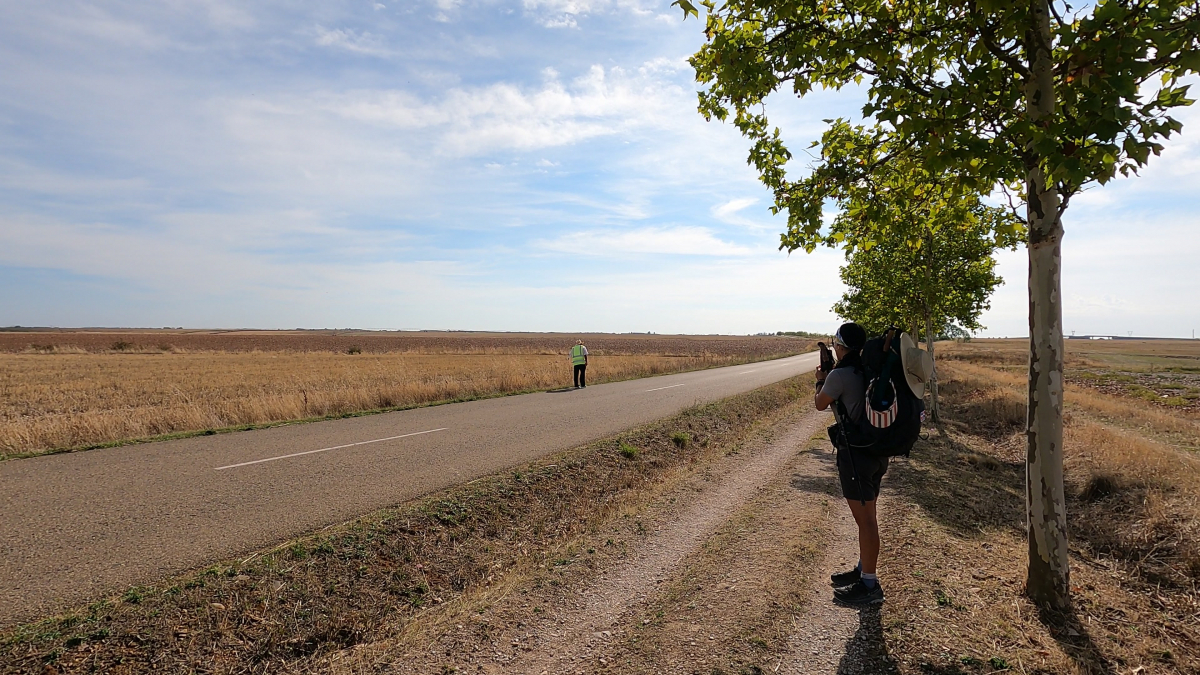
Viva the happy hippy Albergue in Reliegos with the best homegrown tomatoes you will ever eat... ever!
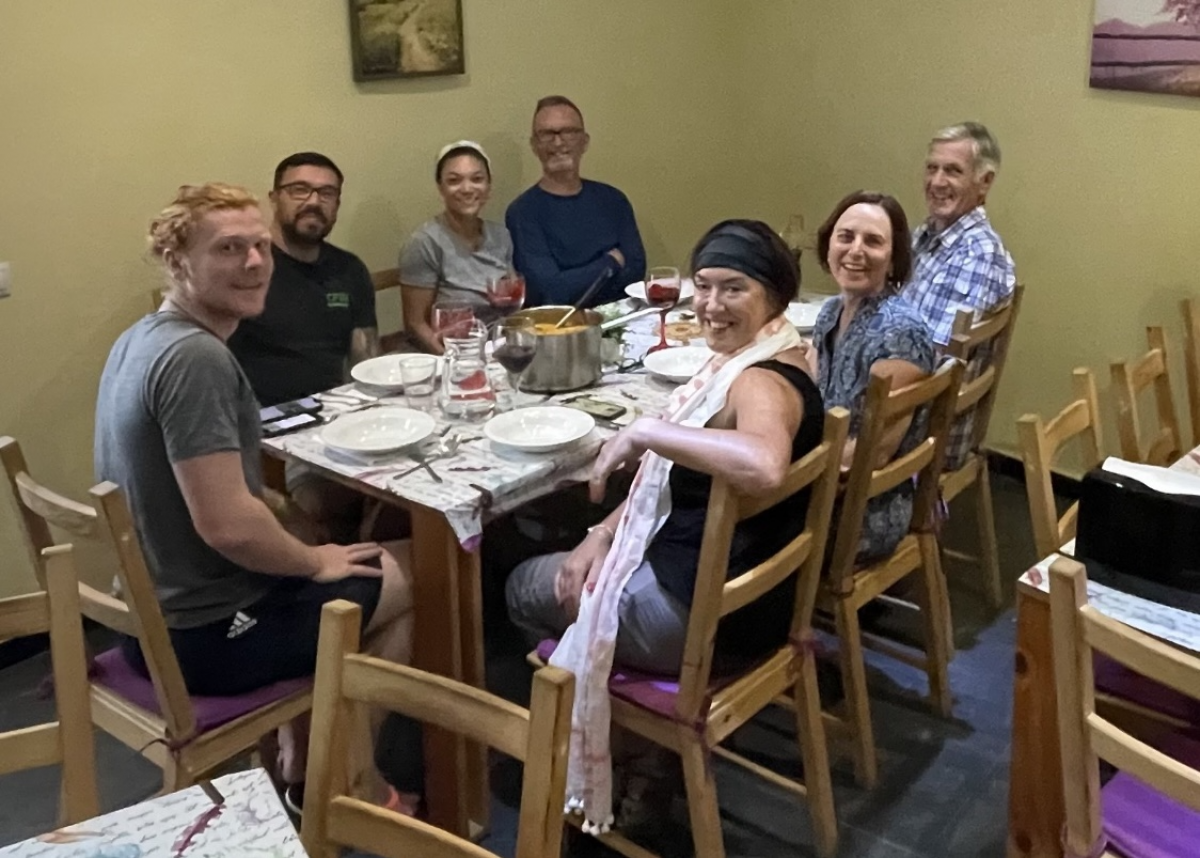
Viva Sor Theresa, in that little Ermita on the way out of Rabe de las Calzadas, who grabs your hands so hard that you will still feel her bony fingers kilometers later because she would not let go of you until she gave you a Pilgrim's blessing. ¡Viva!
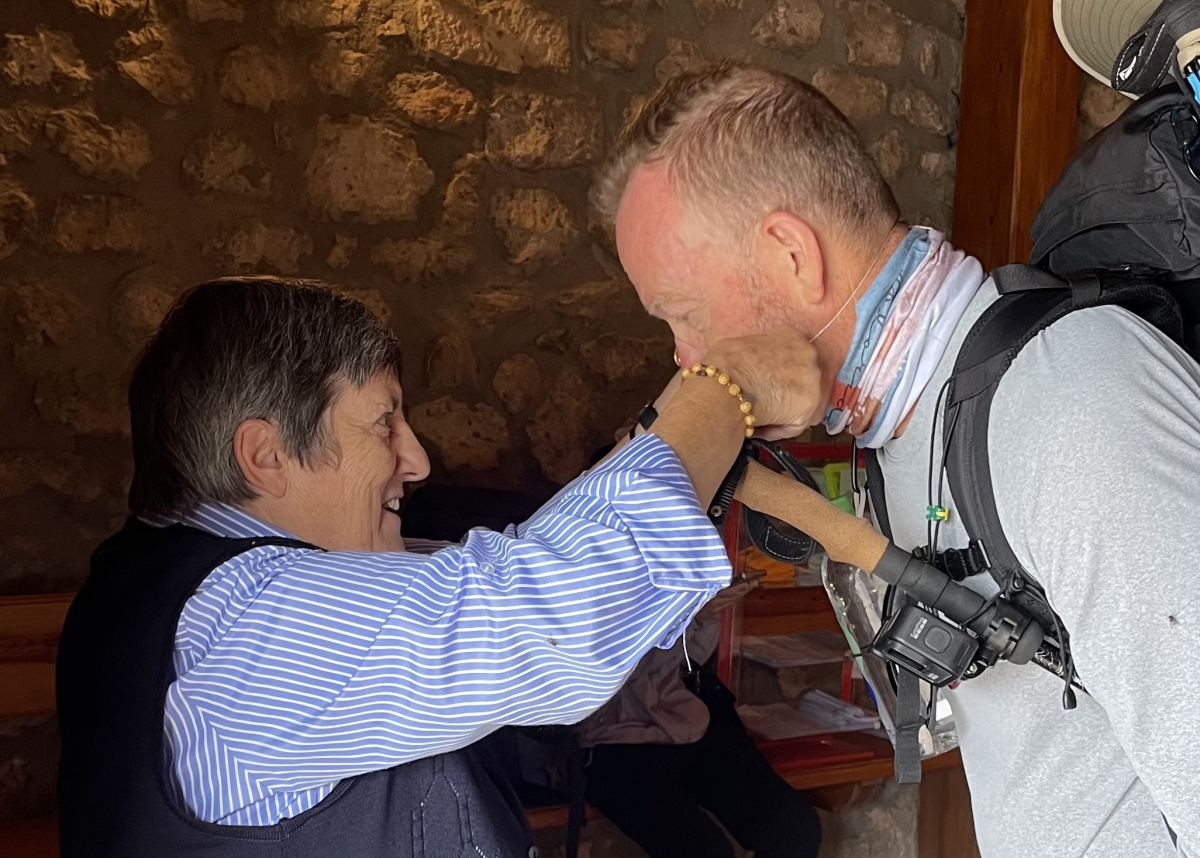
Viva the timing and location of every so-called Camino blessing. Maybe that's what gets you through each day and all the way to Santiago. Likely.
Viva los segundos desayunos, and multiples cafes-con-leches. Vivalos? Why? Because they are little bit of heaven on earth. And because your aching feet tell you to stop and the coffee helps you kick it in gear again.
¡Viva Camino-amigos taking turns buying rounds of 1906s!
Viva the messages in Spanish on those cherished beer bottles.
1906: OUR MOST PERSONAL INTERPRETATION.
"The world belongs to those who have their own vision and dare to show it. To those who, starting from the same ingredients, use their talent and their intuition to do everything differently. Because something that is extraordinary is the result of having a unique way of doing things."
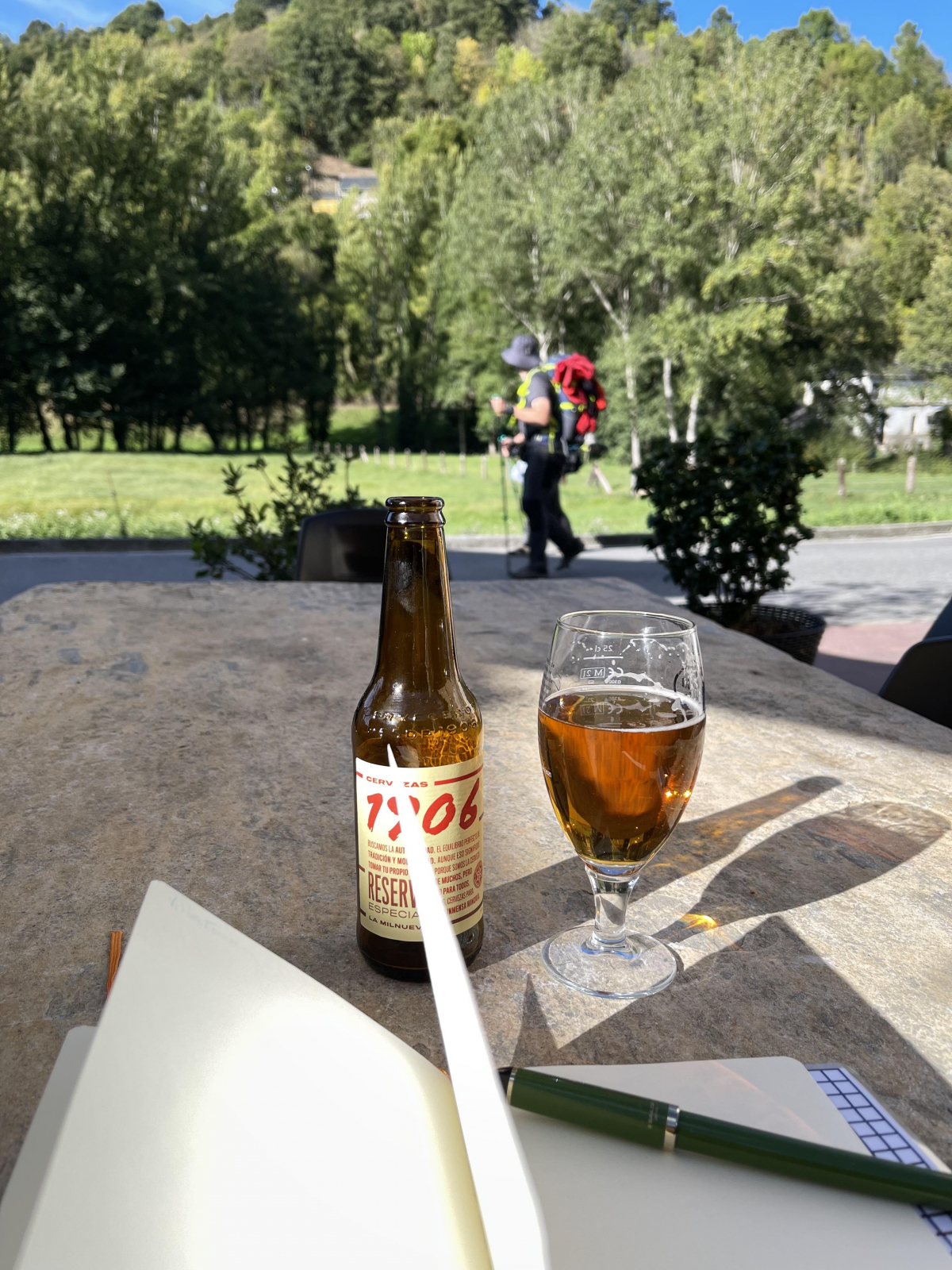
Yup! Viva walking your unique Camino.
Viva la lluvia, and navigando rivers of cow-mierda up and over O'Cebreiro and down through Samos.
Viva how the only two days of rain on your whole darn Camino become the most peaceful, magical part of the journey.
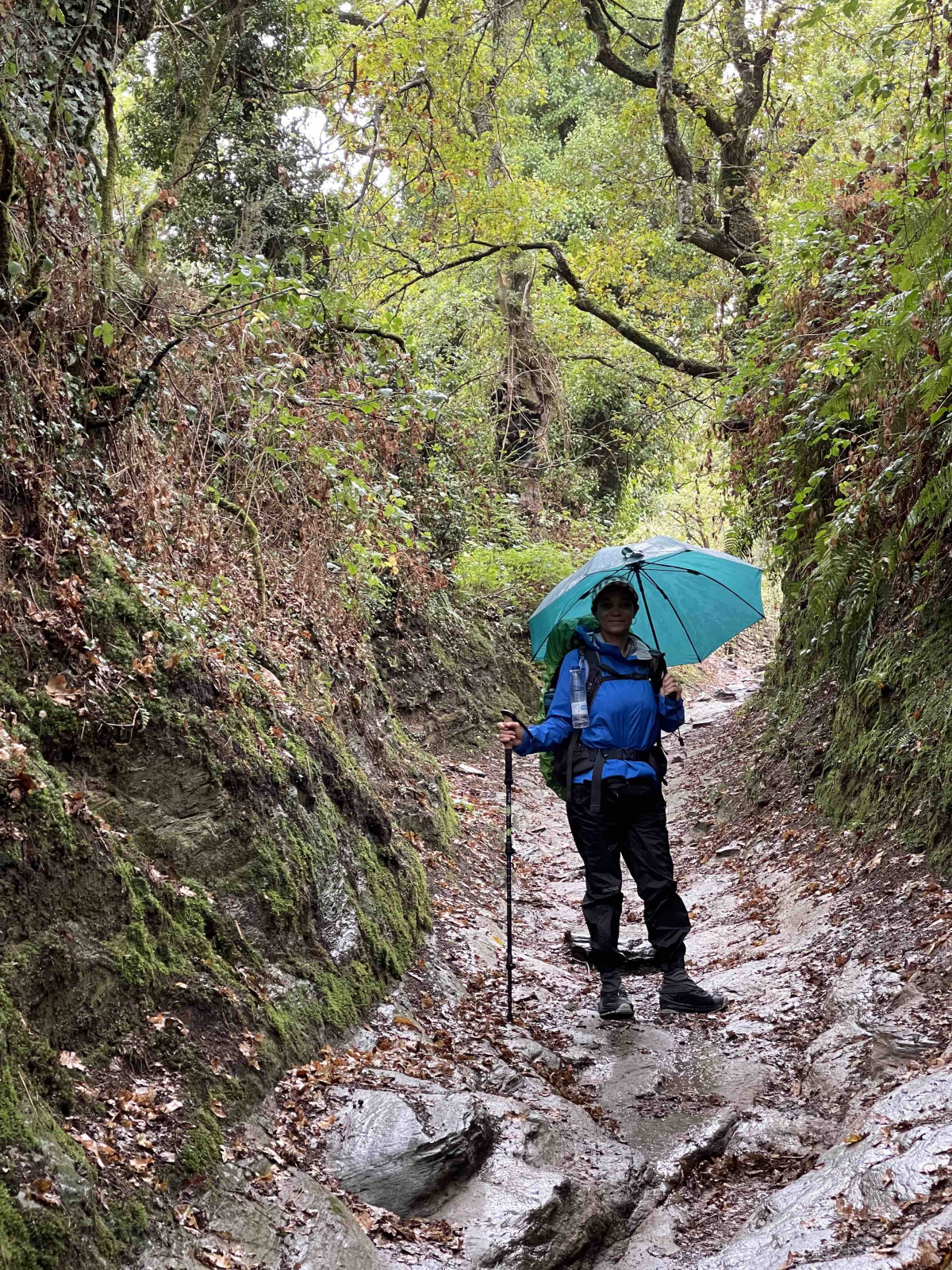
Viva placing your hands on ancient fig, oak, olive, pecan, and chestnut trees that have witnessed thousands, if not millions of weary peregrinos making their way to Santiago and the end of the world.
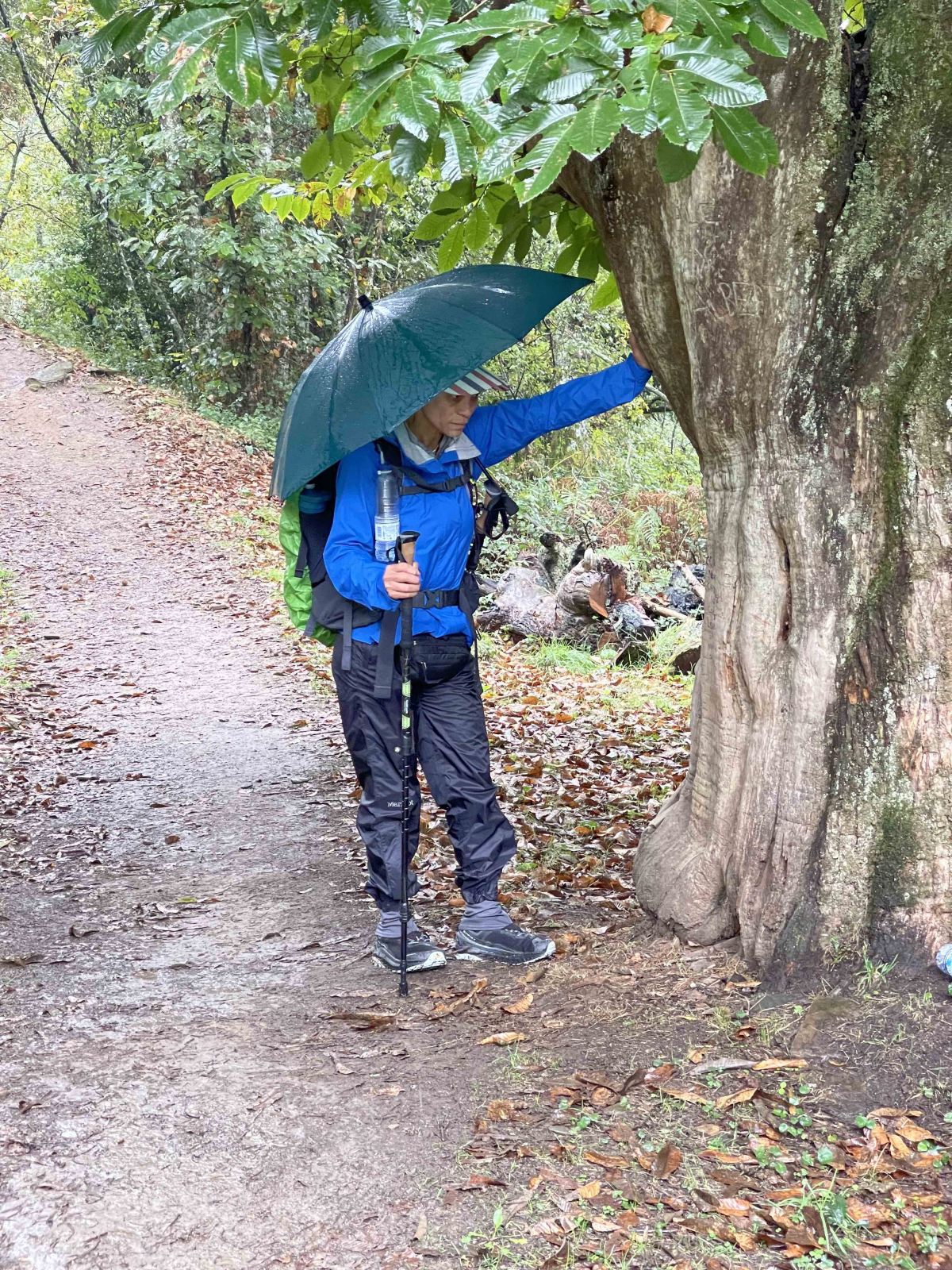
Viva the one-person bar and Albergue operators. Vivan!
Viva the rude pilgrims who show you how to give hospitality to receive hospitality.
Viva the crunch, crunch, metronomic crunch of step after rhythmic step on the crushed rocky paths of the Meseta.
¡Viva la Meseta!
Viva being overtaken and passed on the Meseta by professionals who push and pull wheelchair-bound Pilgrims. Que inspiracion!
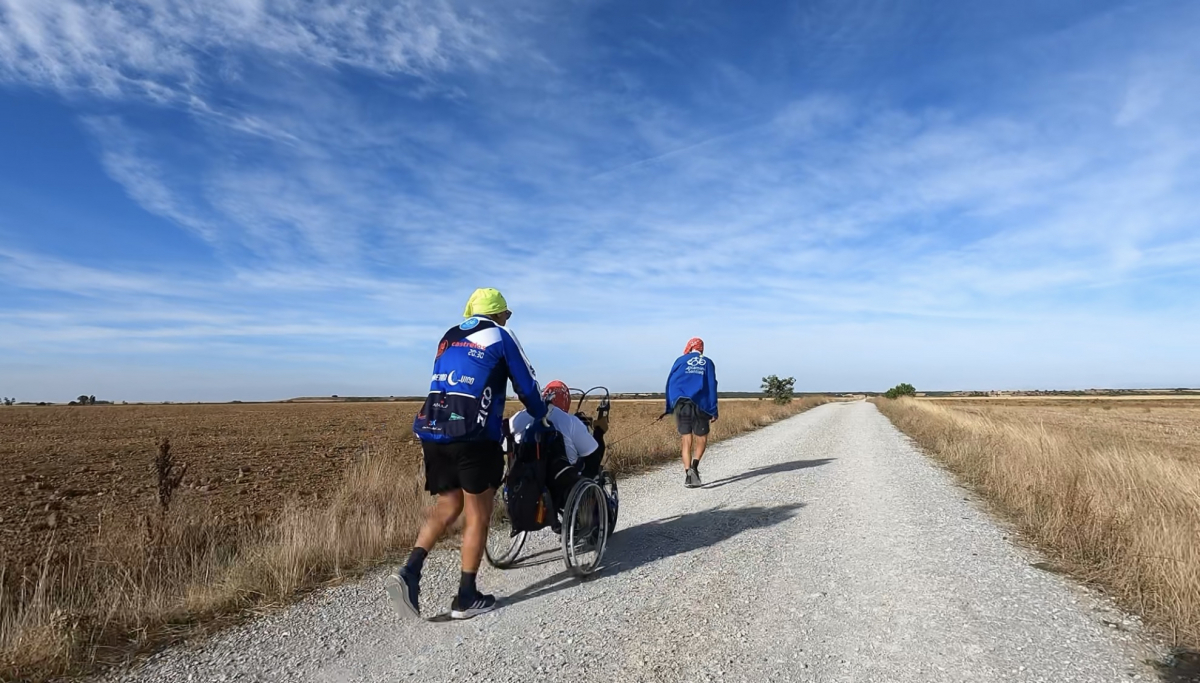
¡Viva La Meseta!
Viva the hospitalero's advice to never forget to look back at where you've come from. Viva taking their advice and breathing in the most beautiful sunrise. Viva needing to turn and walk away from it, with another tear in your eye, because you could have missed it. You would have missed it as you were completely caught up in today's 21-kilometer challenge, and you knowing you, you had better get getting after it.

Viva the slow, agonizing descent for kilometers and kilometers, slipping, sliding, and rolling your ankles on loose shale stones over dangerous hardscrabble until finally making it to Molinaseca, physically drained, emotionally spent, and needing to stop for the day but not stopping because you have a reservation in Ponferrada.
Viva writing in your journal that the next time you will stay in Molinaseca. There will be a next time?
Viva the candle-lit "menus-del-dia" and the pleasures of dining with a couple of retired Spanish brothers living out their dream of walking through Galicia together.
Viva when one of the brothers exclaims, at the dinner table, after a couple of glasses of Ribera del Duero, "Pero que bajo de mierda en Galicia!"
Viva eating roasted chestnuts from street vendors with calloused, burnt fingers from years prying them open and selling them to you, one of the stinky unwashed passing Pilgrim masses.
Viva the multiple times you will hug Camino friends, again, again, and again days later, believing it's the last time you'll ever see each other again.
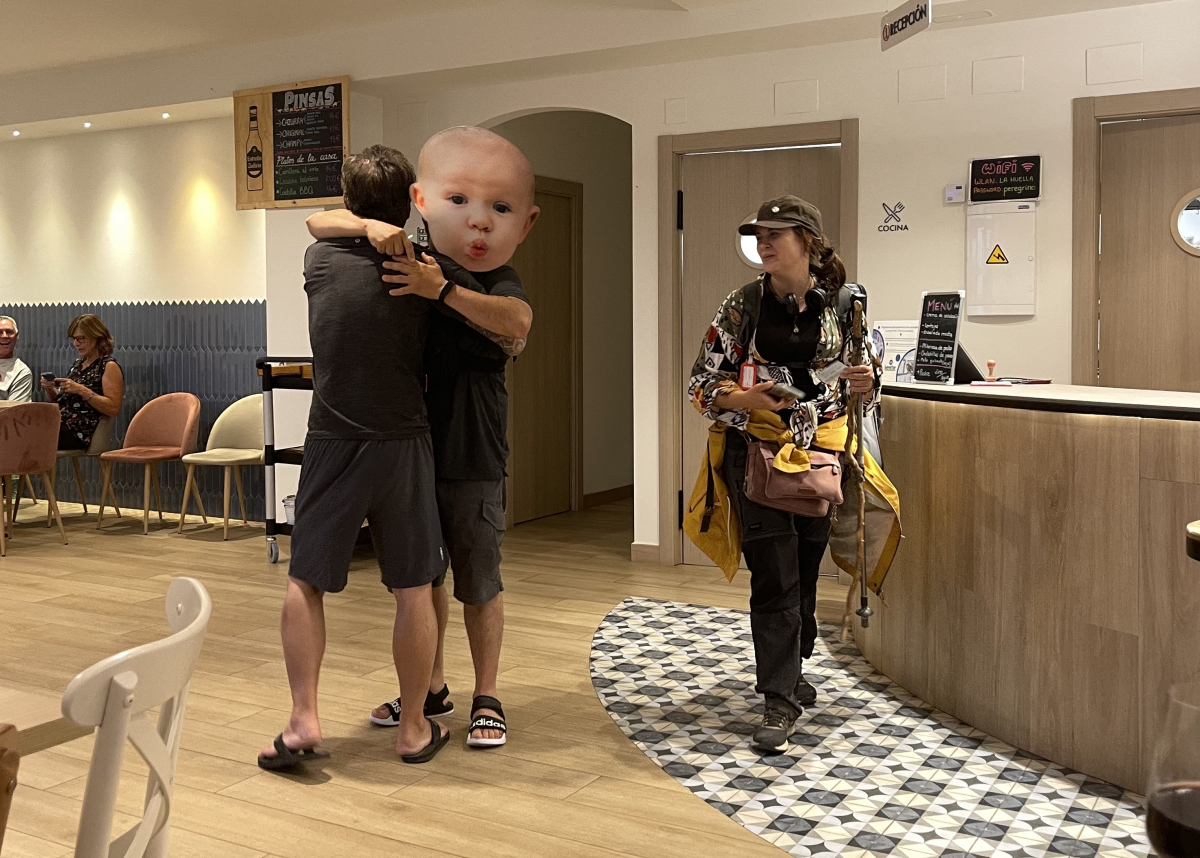
Viva getting the "I made it" Whatsapp message from the Austrian man you shared a taxi ride from Pamplona to Saint Jean but, never saw again. Viva that he realized his dream of walking the Camino after reading Hape Kerkeling's Camino memoir when he was just a 14-year-old boy.
Viva every which way the Camino called each of us who walked it together.
Viva missing your Austrian friend's grand entrance into the Plaza. Viva him missing your entrance because he had to walk faster than you could walk so as to arrive days earlier to be able to get back to work on time.
Viva the joy that always came shortly after dealing with a setback. Always!
Viva how each fear, doubt, and setback become the signposts, the "mojones" of better things to come.
Viva the sound of bagpipes escorting you into the Praza Obradoiro. Viva throwing Euros into the busker's basket. Do the musicians realize the effect they have on us?
Viva days later getting that Whatsapp ding with the "after foto" in front of the Cathedral to go with your "before foto" in Saint Jean from the Mexican Doctor who also shared the taxi ride from Pamplona to Saint Jean Pied de Port, along with you, Cristina and your Austrian compadre.
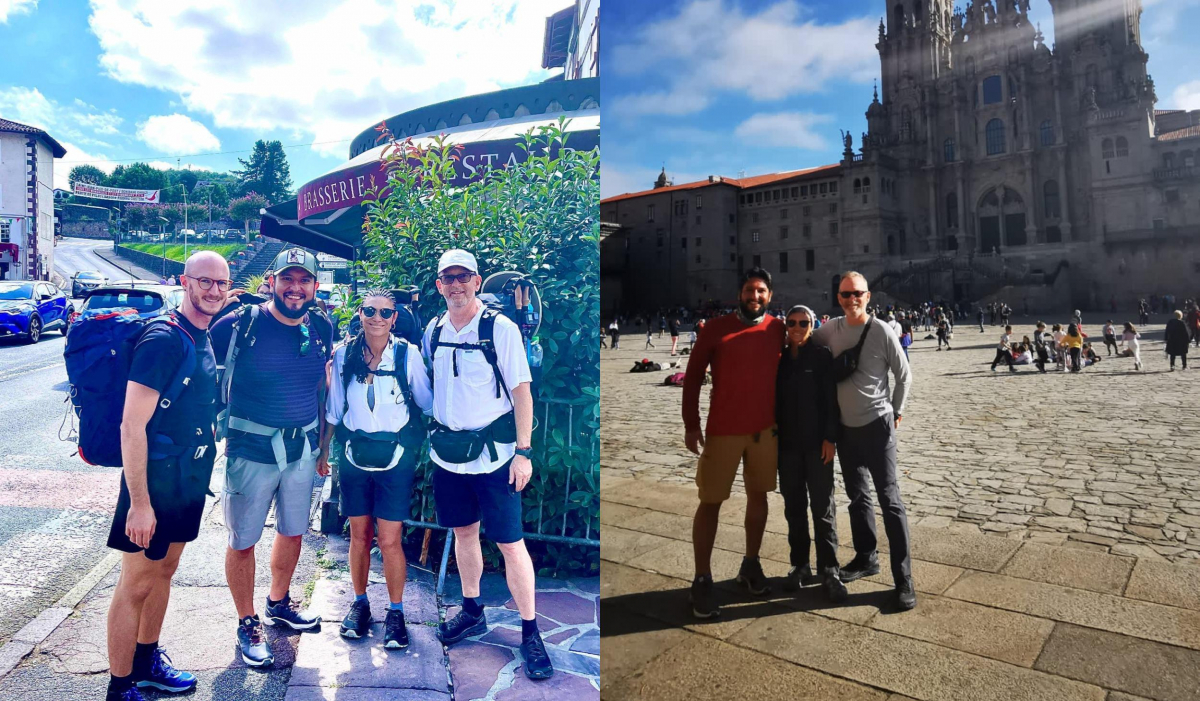
Viva imagining your Austrian friend is there with all of you in that picture, although he is not. He is there in your heart.
Viva all the indescribable that you will be processing, writing, and talking about for years to come.
Viva still not knowing what you want to do with the rest of your life.
Viva understanding, if just a little better, how you will live whatever it is you do choose to do.
Viva the beginning of your next Camino, maybe your "real" Camino?
¡Viva!
If fear is the mind-killer, let me suggest a little hope and faith. Borrow it from me, if need be, or another veteran Pilgrim. They will gladly share.
If it's any consolation, there are millions of us who have walked The Way. May there be millions to follow, making ourselves and the world a little better, one step at a time, passing one mojon after another. Many of us will walk it again if we can but roll the right dice.
PS. Dear Overthinker: Try not to overthink your Camino, tough as that may be. Go live it!
¡Viva La Meseta!
¡Vivalo!
¡Buen Camino!
